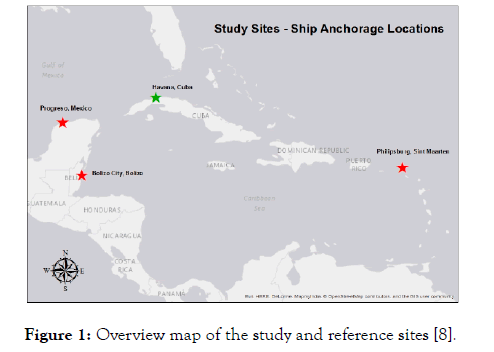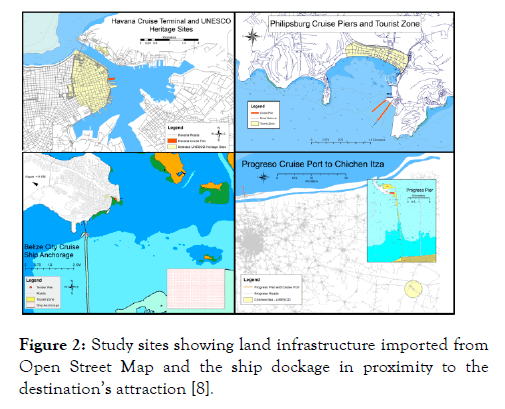Journal of Tourism & Hospitality
Open Access
ISSN: 2167-0269
ISSN: 2167-0269
Mini Review - (2021)
Assessing the environmental, cultural and economic impacts of the Cruise Line Industry (CLI) is an important step in ensuring the long-term sustainability of a destination. With proper planning and implementation, tourism has the potential to make positive contributions to destination ports for the long term. Caribbean islands have been popular cruise destinations for CLI tourism for many years, including American cruise tourism to Cuba when the U.S. government allows it. In order to assess and minimize the impact of CLI tourism on destinations, it is important to conduct marine near-shore and land near-port analysis on the ports used by CLI. This paper provides a short review of Planning and Preparation for Cruising Infrastructure: Cuba as a Case Study and how it determines the potential CLI impact on Havana, Cuba’s port and near-port infrastructure as compared to similar Caribbean destinations, including the methodologies used to do so.
Economic impacts; Tourism; Cruise line industry
Planning and Preparation for Cruising Infrastructure: Cuba as a Case Study starts by noting Cuba’s long relationship with tourism and the CLI. From 1920s tourism by airplane, to Donald Trump and COVID-19 interruption of regular cruise tourism from the U.S., the paper briefly describes some of the challenges that Cuba has encountered in recent history.
Until recently, the impact from CLI tourism on Caribbean destination sites was investigated through a cultural and an economic lens [1,2]. The economic impact continues to be a key issue in tourism management and policy, especially when cruise ship passengers embark on an excursion in and around the destination port [3-6]. In recent years, the focus has shifted more towards environmental impacts from cruise ship pollution, either directly as marine or air pollution or indirectly as waste left at the destination posts [7]. This focus expands beyond the CLI to include the health of coastal areas and ports around the world and serves as the genesis of regulations, like the use of lowsulfur fuel, for cruise ships operating near the coast. Additionally, the UNWTO specifies that sustainable tourism should consider tourist satisfaction as part of the toolkit to promote sustainability awareness.
The paper introduces some of the tools, including nautical charts and vessel traffic information, to help measure the port readiness and its ability to accommodate both larger and an increased volume of cruise ships. The study then moves to identify potential impacts on the local infrastructure that would be used by cruise passengers as they travel to local attractions as part of a cruise destination excursion. Where possible UNESCO World Heritage Sites were used as the attraction. The ports of Sint Maarten, Belize City, and Progreso, Mexico were used as comparisons to Havana in part because of their regional proximity, but they also met several additional criteria including, hosting regular cruise traffic; not being a CLI hub (Miami); offering shore-side excursions (two of the three included UNESCO sites); and accommodating vessels longer than 275 meters (Figure 1).

Figure 1: Overview map of the study and reference sites [8].
The study notes that it would be advantageous to expand its analysis to include impacts like climate change, pollution and sea level rise in order to realize a more comprehensive determination of sustainable seaport planning. Using the International Hydrographic Organization’s GEBCO Cookbook process for chart adequacy [9], automatic identification system (AIS) data with maritime mobile service numbers (MMSI) [10], and Landsat 8 imagery from the U.S. Geologic Survey [11], were used in the marine near-shore analysis. There are no UNESCO World Heritage Sites in Sint Maarten, but it has a port facility that is in very close proximity to the town of Philipsburg. Philipsburg is easily accessible to the cruise ship port and has many shops and restaurants that cater to tourists.
The land near-port portion of the study took advantage of official reports, crowd sourced websites, industry interviews and satellite imagery to analyze travel times and methods from the ship to tourist destinations. Three of the four study sites used UNESCO World Heritage sites as the destination, Philipsburg being the only one that did not. Although the charting products that guide mariners in and out of the Port of Havana are up to date, an increase in marine traffic (correlated with the 17% increase of passengers from 2018 to 2019) would cause a stress on the commerce and local fishing industry that are using the port. Travel times were then re-confirmed using Google transportation. The paper relied on a 2018 study by the Florida Caribbean Cruise Association (FCCA) [12] that included Belize City, Progresso and Sint Maarten to help assess tourist preferences regarding CLI attractions.
The marine near-shore results compared the four sights and showed that the different ports had significantly different natural and manmade barriers to contend with. The Port of Havana appears to enjoy an advantageous natural setting as indicated by the comparison between the nautical chart and satellite derived bathymetry. Good port infrastructure can mitigate land and marine impacts. For example, the cruise ship terminal in Havana has twelve immigration booths, and at the request of the cruise industry, has increased the number of money exchange booths from two to fourteen. The Port of Havana offers a pier to offload passengers in the old quarter of town, so tourists are immediately able to start their shore excursions. The paper then describes the challenges facing the other three destinations. The Port of Progreso employs a fourmile-long pier for docking [13], and the Port of Belize City must use ferries to transport passengers to shore, using approximately 10% of their excursion time [14]. The Port of Sint Maarten is open and can accommodate up to six cruise ships at a time. Imagery and nautical charts indicate that it maintains a relatively deep bottom. The study continues its marine nearshore discussion by analyzing the size and types of cruise ships that each port was able to accommodate (Figure 2).

Figure 2:Study sites showing land infrastructure imported from Open Street Map and the ship dockage in proximity to the destination’s attraction [8].
Using AIS data as part of the land near-port analysis, the study calculated each destination’s maximum potential passenger and crew numbers using the reported ship’s capacity. The paper then notes the large 2018/19 annual increase seen in Havana (18%) as compared to the lower numbers (3-5.1%) in the comparison sites. Based on the AIS information, multiple cruise companies enter each of the study sites. The largest ship visiting Havana was the MSC Armonia (with a maximum capacity of 2679 passengers and 721 crew members). Seasonal trends were also discussed along with a note about possible reasons for an abrupt decline in Havana’s tourist traffic; namely policy changes in the United States. Havana’s positive port infrastructure was discussed as a mitigating factor on both the land and marine sides. The ability to efficiently offload passengers and deliver them directly to the main UNESCO heritage attraction was presented as a benefit that was not shared in the comparative destinations. Though Sint Maarten’s cruise terminal enjoys a close proximity to its main excursion, it is not a UNESCO heritage site [15,16].
The study concludes by recognizing the relative sensitivity, from an economic perspective, that Havana contends with. It also determines that the outlook is likely positive from a cultural perspective if Havana employs protections in the form of planning and resource management to protect its cultural and natural resources. The geographic proximity of Havana’s main attractions to its port is a big advantage, facilitating easy transportation between the ship and attraction. However, Havana needs to be aware of the potential impact on resources like food, water and fuel. Havana’s port infrastructure and plans to modernize it are also seen as positive characteristics of the port, but planning and regulations will be instrumental moving forward.
Lastly, the study acknowledges the impact of COVID-19 and the preparations necessary for similar future industry wide threats. In order to regain passenger trust, the CLI and its destinations must employ clear policies to reduce risk for both passengers and crew.
Citation: Nyberg J, Rice M (2021) Planning and Preparation for Cruising Infrastructure: A Mini Review on Cuba as a Case Study. J Tourism Hospit. S3:002.
Received: 29-Apr-2021 Accepted: 13-May-2021 Published: 20-May-2021 , DOI: 10.35248/2167-0269.21.s3.002
Copyright: © 2021 Nyberg J, et al. This is an open-access article distributed under the terms of the Creative Commons Attribution License, which permits unrestricted use, distribution, and reproduction in any medium, provided the original author and source are credited.